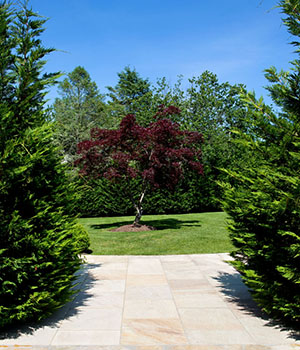In Southampton and East Hampton Town, few words can be as divisive as the word “revegetation”. Many property owners believe that when they purchase a home or land to build their home, they are entitled to develop the landscape as they see fit. Some believe that they can clear the land and improve the property in their own way. Moreover, when they purchase an existing home with beautiful landscape, they assume that the land has not been over cleared and the previous owner had conformed to the rules and regulations of the town. The definition of clearing, according to East Hampton Town, is quite exact, “with the exception of the listed non-native vegetation and dangerous deadwood, the removal of anything from an uncleared area is considered to be clearing. This strict definition is intended to protect the integrity and function of our native ecosystems.” Furthermore, the Town of East Hampton prides itself in having been a “leader in open space preservation for at least 20 years.”
 |
|
Incorrect assumptions about clearing, vegetation, and revegetation can be time consuming and the remedies can be very costly. (Photo: CP Complete, Stacy Wickham Photography) |
Incorrect assumptions about clearing, vegetation, and revegetation can be time consuming and the remedies can be very costly. The Town of East Hampton, Southampton, and Southold each have language that they use and formulas that define how requirements must be met, as it pertains to the clearing of property. Homeowners, having made a significant investment, must know that it is important that you come to the realization that although the requirements may seem restrictive, you have no choice but to conform. It may help to know that quite often protection is the reason for revegetation.
In my professional life, I have been involved in countless situations where I have been asked to “help” clients meet revegetation requirements and bring properties into compliance. Although the task may seem overwhelming, it is manageable. I suggest breaking it down into several categories and approaching the solution systematically, then it becomes less daunting. The first thing to do is identify the challenge. The challenge may have presented itself in one of three ways. You have recently purchased a home and have applied for a permit for a swimming pool, pergola, an addition to your home, or you are planning something else that requires a permit. Upon applying for the permit, the town informs you that you have inherited a property that has been over cleared by the previous owner. You are planning a project requiring that you will be knowingly over clearing the land and you must plan to revegetate with specific and approved plants in a certain area of the property to conform to the laws via replanting. You have been “caught” willingly and knowingly of over clearing and the town has notified you.
In each case, unless you have the time to learn the specifics or have the inclination to dive into the list of required plants that are eligible for complying with revegetation rules, it would be wise to hire a professional to remedy the situation. In every case, we recommend that a surveyor is hired to depict the property’s clearing line (this survey will show clearing calculations). This clearing line defines the amount of clearing permitted on a particular residential parcel using a chart provided by the town. The chart allows you to calculate the parcel size and ratio to the permitted clearing area. There are only a few companies that specialize in this field, and finding one that has expertise is thought to be a wise choice. Precision, efficiency, and careful planning are the only ways to comply. Staying within a budget while also planning to obey the rules, often creates an opportunity to beautify your surroundings.
In my personal life, I encountered a scenario and it was a different story. Despite, knowing the ins and outs of the system, I found myself in a situation where I had to comply with revegetation requirements. As I’ve seen many times with my clients, emotion took over. I pontificate about the fairness of the system and how these rules are for the common good to preserve our beautiful area. But, when it was my home and my land, I couldn’t see why I wasn’t the best person to decide where the clearing ended and where the woods began. I joined the masses in believing that I paid a significant amount of money for my home and no one should be able to tell me what to do with my backyard. Of course, I tempered my approach as I spoke to the powers that be, keeping my thoughts to myself and carefully presenting what I knew needed to be done to comply.
At the end of the day, following the rules actually opened up opportunities to shape my backyard into something that was compliant, functional, and beautiful. Required revegetation is often an opportunity to work in concert with a landscape design/builder to create and execute a plan to enhance the landscape while meeting the requirements set forth by the town. Understanding the approved plant list and the ornamental value of those plants opens up a world of possibilities.
Whether you believe the regulations are restrictive, or if you believe that regulations don’t go far enough to preserve nature’s beauty; being informed and consulting a landscape design/build professional is the first step towards a solution to the revegetation challenge.












